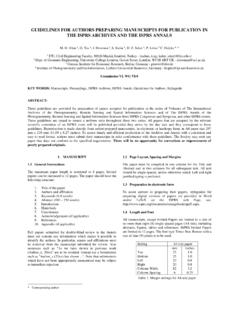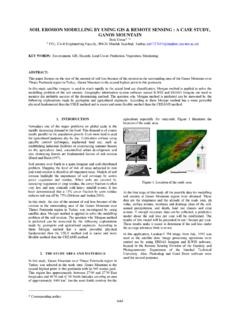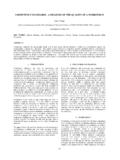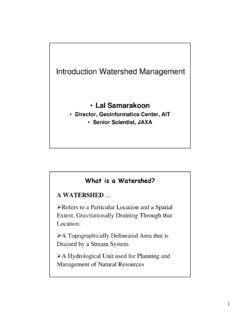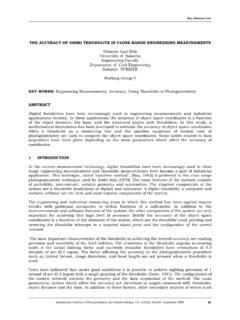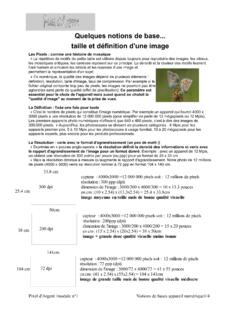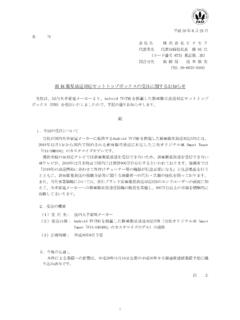Transcription of OBJECT-BASED CLASSIFICATION VS. PIXEL-BASED …
1 The International Archives of the Photogrammetry, Remote Sensing and Spatial Information Sciences, Vol. XXXVIII-4/C7 OBJECT-BASED CLASSIFICATION VS. PIXEL-BASED CLASSIFICATION : COMPARITIVE IMPORTANCE OF MULTI-RESOLUTION IMAGERY Robert C. Weih, Jr. and Norman D. Riggan, Jr. Arkansas Forest Resources Center, University of Arkansas at Monticello, School of Forest Resources, Spatial Analysis Laboratory, 110 University Court, Monticello, Arkansas 71656 Commission VI, WG IV/4 KEY WORDS: LULC, Feature Analyst, OBJECT-BASED CLASSIFICATION , Supervised CLASSIFICATION , Unsupervised CLASSIFICATION , PCA, Multi Resolution ABSTRACT: Land Use/Land Cover (LULC) classifications have proven to be valuable assets for resource managers interested in landscape characteristics and the changes that occur over time. This study made a comparison of an OBJECT-BASED CLASSIFICATION with supervised and unsupervised PIXEL-BASED CLASSIFICATION .
2 Two multi-temporal (leaf-on and leaf-off), medium-spatial resolution SPOT-5 satellite images and a high-spatial resolution color infrared digital orthophoto were used in the analysis. Combinations of these three images were merged to evaluate the relative importance of multi-temporal and multi-spatial imagery to CLASSIFICATION accuracy. The OBJECT-BASED CLASSIFICATION using all three-image datasets produced the highest overall accuracy ( ), while the OBJECT-BASED CLASSIFICATION using the high-spatial resolution image merged with the SPOT-5 leaf-off image had the second highest overall accuracy ( ). While not significantly different from each other, these two OBJECT-BASED classifications were statistically significantly different from the other classifications. The presence of the high-spatial resolution imagery had a greater impact on improving overall accuracy than the multi-temporal dataset, especially with the OBJECT-BASED classifications.
3 1. INTRODUCTION Remotely sensed imagery, in the form of satellite and aerial photography, has become an indispensable tool in resource management and in numerous areas of scientific research. A study by McRoberts and Tomppo (2007) of national forest inventories in Europe, reported that remotely sensed data not only increased the speed, cost efficiency, precision, and timeliness of forest inventories, but also contributed to the development of maps of forest attributes with spatial resolutions and accuracies not previously possible. Methods have been developed for the mapping of large-scale forest cover change (Fraser et al., 2005) and estimating the extent of burned areas (Gitas et al., 2004). Likewise, new analytical techniques have been developed for mapping of urbanization and urban sprawl (Xian and Crane, 2005).
4 In the past, most LULC classifications have been created using a PIXEL-BASED analysis of remotely sensed imagery. They used either a supervised CLASSIFICATION , unsupervised CLASSIFICATION or some combination (Enderle and Weih, 2005). These PIXEL-BASED procedures analyze the spectral properties of every pixel within the area of interest, without taking into account the spatial or contextual information related to the pixel of interest. With the growing availability of higher resolution imagery, this spatial information could be used to produce more accurate LULC classifications (De Jong et al., 2001; Dwivedi et al., 2004). Researchers have generally found that when PIXEL-BASED methods are applied to high-resolution images a salt and pepper effect was produced that contributed to the inaccuracy of the CLASSIFICATION (Campagnolo and Cerdeira, 2007; De Jong et al.)
5 , 2001; Gao and Mas, 2008; Van de Voorde et al., 2004). For decades, GIS specialists have theorized about the possibility of developing a fully automated CLASSIFICATION procedure that would be an improvement over PIXEL-BASED procedures (Blaschke et al., 2000; Csatho et al., 1999; Marpa et al., 2006). Computer software packages such as eCognition and Feature Analyst have been developed utilizing OBJECT-BASED CLASSIFICATION procedures. These packages analyze both the spectral and spatial/contextual properties of pixels and use a segmentation process and iterative learning algorithm to achieve a semi-automatic CLASSIFICATION procedure that promises to be more accurate than traditional PIXEL-BASED methods (Blundell and Opitz, 2006; Grenzd rffer, 2005; Hay and Castilla, 2006).
6 The first objective of this study was to compare the three methodologies ( OBJECT-BASED , supervised and unsupervised PIXEL-BASED classifications). This objective will determine if an OBJECT-BASED analysis of remotely sensed imagery will produce a LULC CLASSIFICATION that is statistically more accurate than a PIXEL-BASED analysis when applied to the same imagery. The second objective was to determine the relative importance of multi-resolution image datasets to CLASSIFICATION accuracy for the above methods. 2. METHODS Study Area The study area was located in and around the city of Hot Springs, Garland County, Arkansas (Figure 1), and included Hot Springs National Park. Hot Springs National Park is approximately 2,250 hectares, while the study area was approximately 16,850 hectares.
7 The study area includes features such as the city reservoir, the city landfill, golf courses, county parks, and several rock quarries. While having some urban areas, the study area was predominantly rural, consisting of fields and pastures, pine plantations, shortleaf (Pinus echinata) and loblolly (P. taeda), deciduous, oaks (Quercus spp.) and hickories (Carya spp.), mixed forests and some urban areas. Hot Springs is at the foothills of the Ouachita Mountains, with elevations in the study area ranging from 107 to 433 meters. The International Archives of the Photogrammetry, Remote Sensing and Spatial Information Sciences, Vol. XXXVIII-4/C7 Figure 1. Location of study area in Garland County, Arkansas, including Hot Springs National Park. Imagery Two SPOT-5 images were used to provide multi-temporal data (winter and spring), each with different foliage characteristics (leaf-off and leaf-on).
8 The SPOT-5 leaf-off image (LeafOff) was acquired on 3 February 2007 with an incident angle of . The SPOT-5 leaf-on image (LeafOn) was acquired on 27 April 2007 with an incident angle of . Both images were processed as Level 1B imagery. A true color (RGB) digital aerial image at 1-foot resolution and a 1-meter color infrared (CIR) digital orthophoto quadrangle (DOQ) were captured using the Leica ADS40 camera system. The CIR image was acquired during leaf-off conditions. Color infrared digital aerial imagery of the study area at 1-foot resolution was also acquired during leaf-off conditions and used for photo interpretation of urban areas to supplement the field data and for the development of the training datasets used in the classifications. The SPOT 5 satellite imagery was orthorectified using a 5-meter digital elevation model.
9 The two SPOT-5 images were resampled to 1-meter when rectified to be coincident with the CIR DOQ pixel resolution. Since we were interested in the comparative value of additional image datasets to CLASSIFICATION accuracy, three different combinations of imagery were created. The CIR DOQ, SPOT-5 Leaf-on, and SPOT-5 Leaf-Off image datasets were merged into an 11-band image (CIROnOff, 1-meter). Likewise, the CIR DOQ and SPOT-5 Leaf-off images were merged into a 7-band image (CIROff, 1-meter) and the SPOT-5 Leaf-on and SPOT-5 Leaf-off images were merged into an 8-band image (OnOff, 10-meter). An OBJECT-BASED CLASSIFICATION was also produced from the SPOT-5 Leaf-on image (LeafOn, 10-meter). Because some of the bands of the merged images were correlated, Principal Component Analysis (PCA) versions of each of the merged images were created.
10 The first four PCA bands were used in the study. The first four bands of the subset PCA CIROnOff image accounted for of the variance in the data. The first four bands of the subset PCA CIROff image accounted for of the variance in the data. The first four bands of the subset PCA OnOff image accounted for of the variance in the data. These subset PCA images, as well as the unmerged LeafOn image, were used in the classifications. Datasets Field data, or ground-truth, was used in the study area to create a test set to access CLASSIFICATION accuracy. Two-person teams, using Trimble GeoXH handheld GPS units, located the positions of randomly selected points within the study area. This GPS data was later differentially corrected, with an error of less than 1-meter. Along with the GPS coordinates, the following data were collected at each location: 1) tree basal area (BA); 2) major and minor tree/plant species based on BA; 3) description of soil/ground cover conditions; and 4) the LULC CLASSIFICATION code.
